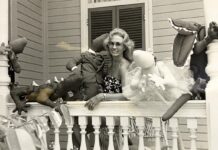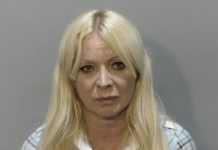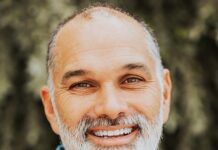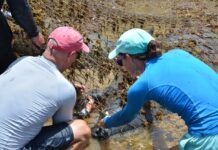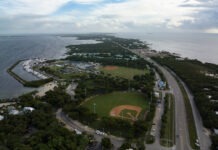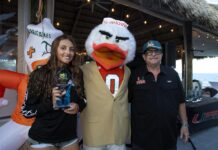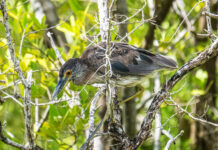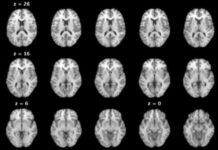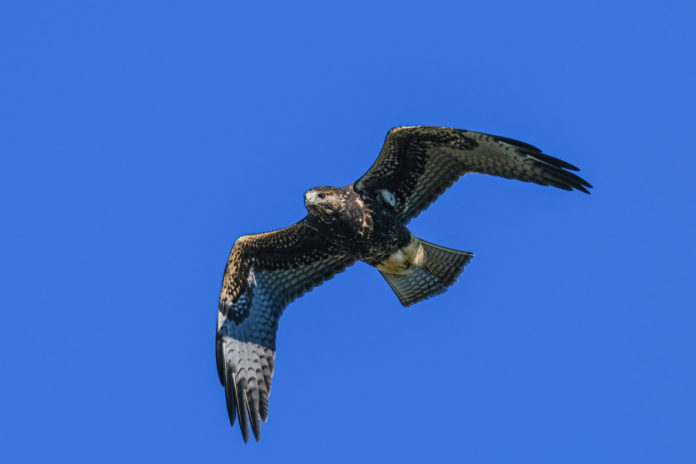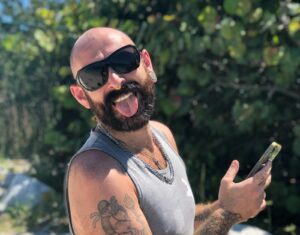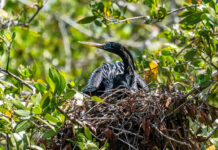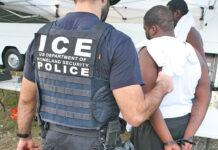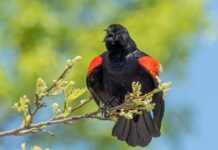It is an odd thing, sitting around, waiting for a bird to poop, but that’s exactly what I was doing — and had been doing for the last half-hour, at least.
My camera was on the table in front of me. A hundred yards away, sitting in a coconut palm, was a Swainson’s hawk, a juvenile, I believe. From a distance it looked not unlike a football balanced atop an arcing green frond. You could have been convinced it was an old coconut if its posture wasn’t so upright.
My interest in seeing the Swainson’s poop was not scatological. Birds poop before they fly, like a poker tell. General opinion says it’s a way of lightening the load, while also perhaps preventing a sneak attack from behind. I’ve been looking for a scientific term for this phenomenon – exit elimination? defensive defecation? – but so far, no luck, despite it being a phenomenon every birder knows.
The hawk had flown by me earlier, chased by a screaming osprey that considered it an intruder. Despite the racket, I didn’t catch onto it until the last second, and only got a blurry shot of the bird with one wing out of frame.
I went through the mandatory period of disappointment and self-recrimination after that, and was starting to shift my thoughts to other things, when I noticed that same Swainson’s perched up in the coconut palm. So in theory, to get a better shot, all I had to do was sit there and wait for the bird to poop before taking off, and if it flew towards me, I might even get a good shot.
While I was sitting there, I kept thinking about the Scottish wildlife photographer Alan McFadyen. Actually, I wasn’t thinking about him – I had to look up his name to write that last sentence – so much as the one shot he took that went kind of viral for its technical perfection. It was of a common kingfisher, a diving bird, shot in total symmetry and amazingly good light, bullet straight, with its bill just barely piercing the surface of a still lake. In all the stories about it, McFadyen said it had taken him approximately six years, 4,200 hours, and 720,000 frames to get the picture he wanted. Technical brilliance is not what I love about photography, but whenever I screw up a shot, or get impatient, the visage of McFadyen, or at least my imagined version of him, is standing there in my psyche, arms folded, shaking his head at my lack of perseverance and preparedness. The f&%^ing apple polisher.
If it was any other bird, or at least most other birds, I probably wouldn’t have waited a half-hour. But Swainson’s hawks aren’t overly common in the Keys, or even east of the Mississippi, and while we see a small number here every year, it’s only for a couple weeks, usually in November.
Swainson’s hawks are known for their near-uniform behavior. Pretty much their entire population abandons North America every fall to fly more than 6,000 miles to Brazil. Almost 350,000 of them have been counted migrating through Panama City, Panama in a single season. Almost 850,000 of them have been counted passing over hawk count sites in Vera Cruz, Mexico in a single season.
We get about 65 of them flying past the Florida Keys Hawkwatch every year, mostly young birds, mostly birds that should have taken that left turn at Albuquerque. For some reason most of them are seen in November, when the winds tend to come up, and they don’t stay very long, presumably deciding, once they’re all the way down here, to cross over to Cuba, so they can island-hop south.
They are such beautiful flyers, though, strong, assured, direct.
When the hawk had initially landed in the tree, I held up my camera, figuring he was going to take off again at any second, but as time went on and my arms began to numb, I started lowering in the interest of blood circulation. Then the bird would twitch or turn its head or fluff out its feathers and I’d hold the camera up until my arms went numb again.
Finally, the bird did it – leaned forward, raised its tail feathers, and let out a long, skinny stream of white stuff. Then he shuffled his feathers again, stepped out into the air, and opened his wings.
His back had been towards me, and when he made the move, I feared I’d been sitting there for half an hour just to have the bird fly the other way, but he made a quarter turn, flew a little more, then banked again. I raised my camera, but the bird was nothing but a blur. I lifted my finger and replaced it on the focus button several times, with the same results.
You’re just going to screw this up again, aren’t you? I thought. Then the autofocus hit, and the bird came sharp in the lens. I got a shot off, then a few more, and kept shooting, even as the bird passed over and flew away, even though I decided a while ago that I really don’t need any more shots of birds flying away.
I started chimping on the back of the camera, clicking through the series to see if I got anything good. Three or four of them were actually not bad. It wasn’t anything that was going to go viral the way McFadyen’s perfect kingfisher did, but I was OK with that.
Got a bird question you’re dying to ask, or even just mildly curious about? Email ‘Ask the Bird Geek’ at mark@markhedden.com.
